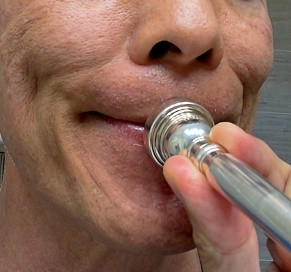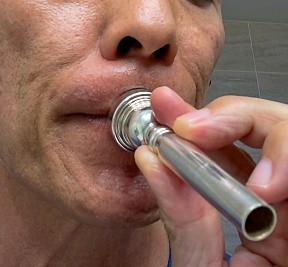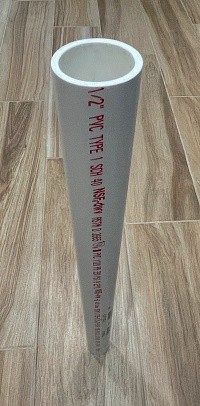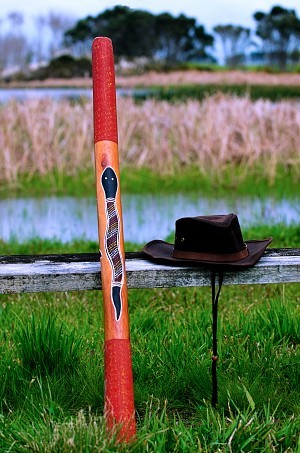In this episode we are gonna discover how to really change your embouchure. Change my embouchure? Are you nuts? Well, if you are playing and developing well, please move along to the next post, like Cool Songs You Can Play Along With. If however you are stuck, or had let’s just say, not the best teachers in your youth and have a limiting brass embouchure like me, keep reading. Just don’t smile.
Table of contents
- How do I fix my trumpet embouchure?
- What have I done to fix my trumpet embouchure?
- How long does an embouchure change take?
- How do I improve my trumpet embouchure?
- What is the correct trumpet embouchure?
- Trumpet Embouchure basics
- Tongue placement in embouchure formation
- What I learned from my embouchure change
How do I fix my trumpet embouchure?
This has been the “Holy Grail” of quests I’ve been on for the past few years or so. I’m trying to lose my “smile”. My Smile trumpet embouchure that is. I want a good embouchure. Which is very much not my Smile embouchure. Why? I got to first chair within 4 months of first learning the trumpet (it was a cornet back then). I reached 1st chair trumpet for the Honors band (the top band usually reserved for Seniors only) in high school and I was only a junior. I played 1st chair trumpet in Jazz band when I was a junior as well. Actually these weren’t that big of deals as the Senior trumpet players above me were more into sports than trumpet playing. I could hit an F above the staff. So why change? Lots of reasons. I suffered from poor endurance. When I did play high, it wasn’t consistent or controlled. My tone quality was thin. I was very limited in terms of how far my trumpet performance capabilities would go. Every facial muscle would tire quickly as they pulled the lip taut. Decades later, I’ve learned that indeed, my Smile embouchure while it “works”, limits my trumpet playing. Yamaha Master Educator, Dr. David Cutler discusses in his article “Fix it: Trumpet Teaching Tips” Embouchure problems to watch for. And guess what? #1 on Dr. Cutler’s list is the Smile embouchure.
“Smile” embouchure thins out lips, limits range and endurance, and produces thin sound.
Dr. David Cutler, Yamaha Master Educator
What have I done to fix my trumpet embouchure?
Well, let’s see:
1. Learn. I researched and researched. Watched pretty much all of YouTube. Well, it felt like that. Every video that discussed the brass embouchure. Every trumpet player that had some valuable insights.
2. Apply. I tried to do very different things than what I used to do. Specifically to unlearn the old embouchure. I tried to apply what was written about the different embouchure types like Farkus, Stevens, even Maggio (just so I understood what he did to get around his injury). The funny thing is, my lip thought I was doing something different, but they had very strong muscle memory so my lip would regress back to the Smile embouchure. I also am playing on a much deeper cup mouthpiece than I used to. Let’s just say I used a really shallow mouthpiece in high school just to be able to get above the staff.
3. Lessons. I took a trumpet lesson from 2 different instructors. These were video call lessons as these world class teachers weren’t just down the street from me. Both looked at me, recommended I try a few things. But since I could barely play a C major scale ending in the middle of the staff, they shook their heads and recommended I start with the first exercises in the trumpet method books like Arbans. Try lip slurs, arpeggios, and scales. The result? Nothing. Nada. I still couldn’t play above the C in the middle of the staff without it cracking.
In the two images below, I’m lip buzzing a G above the staff (I think). Notice how the Smile embouchure has the cheek muscles pulling the lips taut. In the Correct embouchure (right image) my corners are firm and there is little tension in my cheeks. Actually, my facial muscles are much more relaxed. The sound with the incorrect Smile embouchure was thin. The sound from the correct embouchure (correct for me that is) was full, dark, and loud. Best of all, it felt effortless.


How long does an embouchure change take?
In stalking the many trumpet forums out there, I’ve read that many trumpet players when making an embouchure change get frustrated at how long it takes. Many posts were by students, either in high school or college. These trumpet players took at least a year or two to get back to where they were. I’m “ahem” a little older than those players. Which means, it’ll take even longer. Or will it? The definition of insanity is doing the same thing and expecting a different result. I realized I needed to try something very different to fix my problem.
How do I improve my trumpet embouchure
In several posts in various trumpet forums, Clint “Pops” McLaughlin came up as an amazing trumpet teacher. I went to his website and read and watched everything he had up there. I purchased his course “Tensionless Playing: Made Easy”. This really opened my eyes. The idea is simple, let the air do the work. But something was still missing. I had lots of breath support, but the face was doing the wrong things. I found a more encompassing course of his, “Be Your Own Teacher: Do it yourself Embouchure Change” This was exactly what I was trying to do. Full disclosure: “Pops” has no idea I’m writing this. I’m doing this to share my experiences from going through his teachings.
Back to his courses. “Pops” started off talking about how most trumpet players start in elementary school and are left on their own to play the trumpet. And that results in things like the Smile embouchure. This described me perfectly. Sadly, not one of my teachers thought to let me know this was going to be a problem. Did I take lessons? Yes, but did they fix my embouchure? Nope. Sure enough, I used way too much tension and mouthpiece pressure. I had range, tone, and endurance problems. Just as he described in his lessons.
The big thing that was different for me was using a didgeridoo. WHAT???? A didgeridoo is a long tube wind instrument that is blown into to create a droning sound. You know the one, that sound that always comes on when a show or movie is in Australia. It comes from the Aboriginal people of Australia. So I went to the outback of Australia, found an Aboriginal Elder, and I spent the next several years eating bugs and learning how to play the didgeridoo. Oh wait, that was a dream. What I did do is go to my local hardware store, bought a piece of white plastic pipe (2″ PVC), sanded the edges to be rounded, and blew into it. Nothing came out. So I read the lessons by “Pops” again and he explained that you have to relax for it to make that droning sound you hear in every movie or show about Australia. Every try to play a tuba or trombone mouthpiece? It’s kinda like that, but with no back pressure to help you buzz. By holding your corners and relaxing your lips, you can get that familiar drone. So what does this have to do with trumpet playing? Tensionless playing. Remember the first lesson? By learning to hold my the corners of my mouth, saying “EM”, and relaxing the lips was the keys to changing from a Smile embouchure to what “Pops” calls a closed embouchure that has a small aperture tunnel. Lots of stuff here, check out “Pops” site here and teachings to learn more.

What is the correct trumpet embouchure?
Back to the main quest I’ve been on. We explored what a good trumpet embouchure in terms of what most of the teaching methods recommend in our 5 Brass Embouchure Fundamentals. These fundamentals can be applied to any brass instrument. The “correct embouchure” as a brass player, is one where I don’t use my cheek muscles to pull the lip taut. In fact, not using the check muscles at all (just don’t puff them outward like Dizzy unless you can play like him, then more power to you !). Further, put more mouthpiece pressure on the lower lip when playing. Or not using a lot of muscles heavily. Far less tension in the face. That’s what the didgeridoo is doing for me. To make that familiar droning sound, you have to relax. I had a hard time getting the drone sound when I first started. In reading through “Docs” lesson on DIY Embouchure change, he explains how relaxing is the key to playing loud and high. So I’ve spent the last several months away from my trumpet. Yep, just didgeridoo playing and mouthpiece buzzing. The idea is that I set the corners of my mouth and hold them firm. I wet my lips and blow. I can practice a lot longer as my embouchure muscles aren’t really being taxed liked when I was younger. In case you wondering, I’m playing on a Yamaha Bobby Shew Jazz mouthpiece. For more info on mouthpieces, here’s our Mouthpiece Guide post.
Trumpet Embouchure Basics
In looking at the various resources for a band director, there is a ton of information that I wish my teachers and band teachers would have looked at. When I think back, I realize that there what separated a good trumpet player from a not so good one was proper fundamentals that came from quality lessons. Back then, the mouthpiece placement guidance was to put 2/3rds of the mouthpiece on the upper lip and 1/3 on the lower lip. The current thinking is to use a 50/50 placement on the upper lip and lower lip. I’ve found this trumpet mouthpiece placement really helps my sound when playing my horn. Best of all, I use a fraction of the mouthpiece pressure I used to.
Tongue Placement in Embouchure Formation
Why I bring this up is that the I’ve learned that the tongue has a very important role in brass instrument playing. For trumpet playing, it’s like the octave key that the saxophone has. The idea is simple. The legendary “Doc” Severinsen talks about how to play high notes is like putting your thumb over the end of a hose as it shoots water out. By placing your thumb over part of the opening of the hose, the space that the water comes out of is reduced. This in turns increases the velocity of the water. The National Library of Medicine’s paper: “Fundamentals of Embouchure in Brass Players: Towards a Definition and Clinical Assessment” talks about the importance of not only the tongue, but our teeth as well.
“A new definition for embouchure is proposed: embouchure is the process needed to adjust the amount, pressure, and direction of the air flow (generated by the breath support) as it travels through the mouth cavity and between the lips, by the position and/or movements of the tongue, teeth, jaws, cheeks, and lips, to produce a tone in a wind instrument.”
National Library of Medicine, Woldendorp KH and others.
What I got out of this is that the venturi effect is created by using tongue arch (arching your tongue towards the roof of your mouth to decrease the size of the oral cavity. “Pops” recommends a forward tongue arch. This is where you touch the tip of your tongue to the back of your lower teeth and the arched part of your tongue is more towards the back of your upper teeth. “Pops” doesn’t recommend a rearward tongue arch. This is where the arched part of your tongue is held towards the back of your mouth to reduce the oral cavity towards the back of your mouth. His reasoning is, it is harder and takes more effort. And yes, the trumpet blogs I’ve been stalking are full of various opinions on this topic.
Another change for me was trying to extend my lower jaw so my lower teeth were more in line with my upper teeth. I have a slight overbite (as most people do). By moving my lower jaw, I have a more even surface for the upper and lower lip to be supported. I can also create a much better seal of the mouthpiece against the lips without a lot of pressure. I asked “Pops” for recommendations on this and he said move my lower jaw forward a little, not the full 1/4″ needed for the upper and lower teeth to be in line. By moving my jaw outward, it also allows me to put most of the pressure of the mouthpiece on the lower lip which in turn allows the upper lip more freedom to move and vibrate.
What I Learned From My Trumpet Embouchure Change
How has “Pops” lesson been doing for me? Well, I feel like I’m on my was to a proper embouchure. I no longer have what most would consider a “student’s embouchure” but one that will let my trumpet playing go where it never had been. “Pops” teachings have been transformative for me. He talks about a “set point” where if you set up your embouchure for low notes, it’s harder to play higher. If you set your lip at a G above the staff, the C above the staff is only a third away. And playing lower is easier as you just relax your lip muscles. After months of just playing the didgeridoo and mouthpiece buzzing, I put my horn to my face. I could actually play a C above the staff and play up to and (and this was a life changing moment for me) hold the G. Yes, the G above the C. I never could even squeak a G out much less play it. Did it sound great? Well, no. But it sounded okay. I remember someone saying “Squeaks turn into notes” or something like that with regards to the upper register so I’m hopeful.
Do I recommend “Pops” lessons? Absolutely. Is he paying me to say this? Absolutely not. For me, it was very clear that as a very distinguished trumpet teacher, he not only understood my issues with the Smile embouchure, he knew how to fix it. That was the “golden nugget” that I have been looking for. Someone that understood why I was doing what I was doing (incorrect instruction at the beginning, no corrective teachings, etc.), the problems it will cause (thin sound, poor endurance, limited range), and how to fix it. Do I see myself taking lessons from “Pops” in the future” ? Absolutely. What I was amazed at is that when I had some questions, I emailed “Pops”. He responded within a day with clear answers. Not only answers, but backed it up with why I should do certain things a certain way.
Am I there? Have I completed my embouchure change? Well yes and no. I still “Smile” when I inhale and that has to change. In general, I do feel like I’ve changed things fundamentally. But my sound has a long way to go, my control has a long way to go, and reading those black things on those 5 lines has a very long way to go. I don’t use our Fingering Chart as I’ve muscle memory has been my friend. Trying to remember that G flat is the same as F sharp sometimes makes my brain hurt. Trying to remember what those things are and translating them into the movement of my fingers is a whole different Ted talk.


